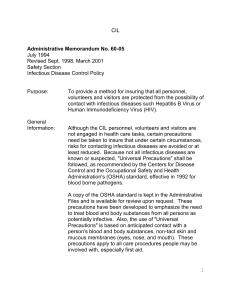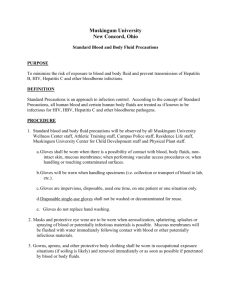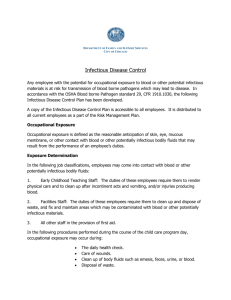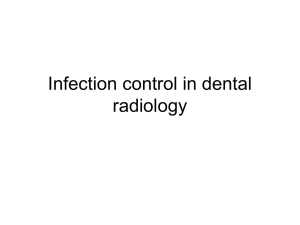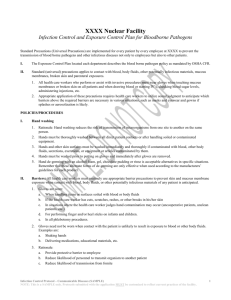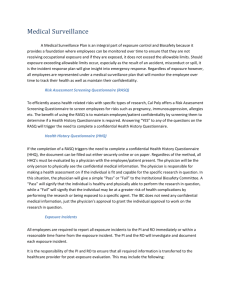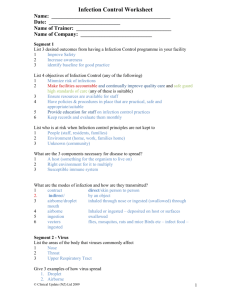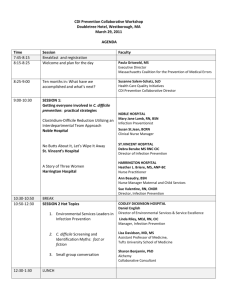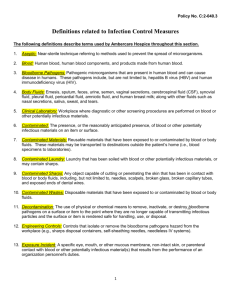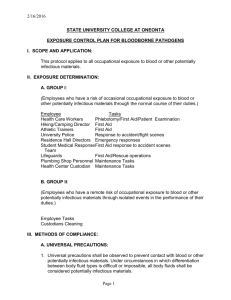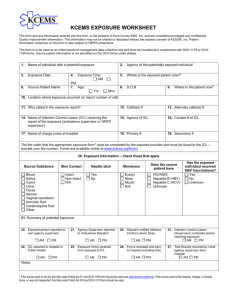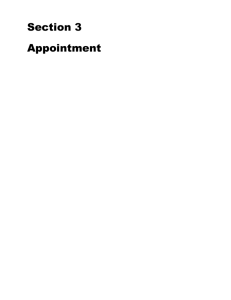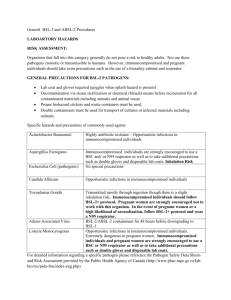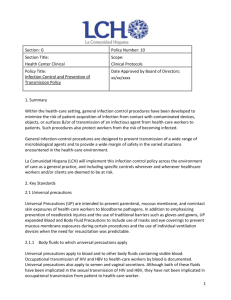iii. hand washing procedure
advertisement
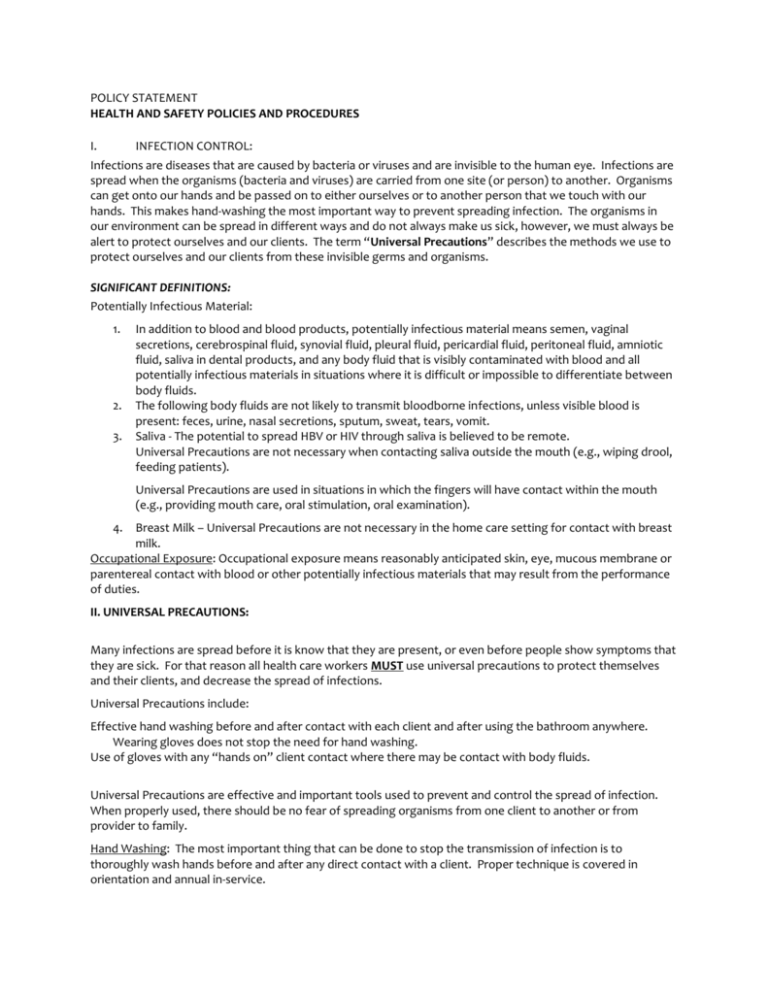
POLICY STATEMENT HEALTH AND SAFETY POLICIES AND PROCEDURES I. INFECTION CONTROL: Infections are diseases that are caused by bacteria or viruses and are invisible to the human eye. Infections are spread when the organisms (bacteria and viruses) are carried from one site (or person) to another. Organisms can get onto our hands and be passed on to either ourselves or to another person that we touch with our hands. This makes hand-washing the most important way to prevent spreading infection. The organisms in our environment can be spread in different ways and do not always make us sick, however, we must always be alert to protect ourselves and our clients. The term “Universal Precautions” describes the methods we use to protect ourselves and our clients from these invisible germs and organisms. SIGNIFICANT DEFINITIONS: Potentially Infectious Material: 1. 2. 3. In addition to blood and blood products, potentially infectious material means semen, vaginal secretions, cerebrospinal fluid, synovial fluid, pleural fluid, pericardial fluid, peritoneal fluid, amniotic fluid, saliva in dental products, and any body fluid that is visibly contaminated with blood and all potentially infectious materials in situations where it is difficult or impossible to differentiate between body fluids. The following body fluids are not likely to transmit bloodborne infections, unless visible blood is present: feces, urine, nasal secretions, sputum, sweat, tears, vomit. Saliva - The potential to spread HBV or HIV through saliva is believed to be remote. Universal Precautions are not necessary when contacting saliva outside the mouth (e.g., wiping drool, feeding patients). Universal Precautions are used in situations in which the fingers will have contact within the mouth (e.g., providing mouth care, oral stimulation, oral examination). 4. Breast Milk – Universal Precautions are not necessary in the home care setting for contact with breast milk. Occupational Exposure: Occupational exposure means reasonably anticipated skin, eye, mucous membrane or parentereal contact with blood or other potentially infectious materials that may result from the performance of duties. II. UNIVERSAL PRECAUTIONS: Many infections are spread before it is know that they are present, or even before people show symptoms that they are sick. For that reason all health care workers MUST use universal precautions to protect themselves and their clients, and decrease the spread of infections. Universal Precautions include: Effective hand washing before and after contact with each client and after using the bathroom anywhere. Wearing gloves does not stop the need for hand washing. Use of gloves with any “hands on” client contact where there may be contact with body fluids. Universal Precautions are effective and important tools used to prevent and control the spread of infection. When properly used, there should be no fear of spreading organisms from one client to another or from provider to family. Hand Washing: The most important thing that can be done to stop the transmission of infection is to thoroughly wash hands before and after any direct contact with a client. Proper technique is covered in orientation and annual in-service. Hands and other exposed skin surfaces are to be washed: (a) before and after direct client contact. This includes before putting on gloves and after taking gloves off. (b) immediately and thoroughly if inadvertently contaminated with blood or other potentially infectious materials. Disposable Gloves: Disposable gloves are to be worn whenever there is a possibility of contact with client’s blood or other potentially infectious material, contact with mucous membranes, contact with non-intact skin, handling items or surfaces soiled with blood or other potentially infectious material. Disposable gloves are to be changed during procedures if they become torn or otherwise damaged. Gloves are to be disposed of after each use. They are not to be reused. Health Care Providers/Employees with Exudative Lesions or Weeping Dermatitis: Health care providers/employees with exudative lesions or weeping dermatitis may not have direct client contact unless it has been medically determined that they can safely perform work activities. Providers/employees for whom it has been determined that they cannot safely perform work activities will refrain from direct client contact until the condition is resolved. III. HAND WASHING PROCEDURE Purpose: To assist in infection control by listing indication for hand washing. To provide knowledge of the steps to be taken to ensure thorough cleansing of hands. Hand washing to prevent the spread of infection must be practiced by ALL individuals in contact with clients. It is the responsibility of each person to protect themselves and others. Indications for thorough hand washing using soap and water: Before and after every direct client contact Before and after the removal of protective equipment Hand Washing Procedure: a) Remove all jewelry from hands. Use paper towel to turn on the faucet as well as to obtain soap from container to prevent transfer of bacteria. Discard paper towel. b) Wet hands with water. Apply and spread a thin film of soap over the entire skin surface. Wash thoroughly using continuous running water, with a rotary motion and friction. Avoid running water down elbows. c) Do not touch the inside of the sink. d) Work soap into the ends of fingers and clean the nails. e) Rinse thoroughly and frequently under running water. f) Repeat steps “b” and “d” as often as needed. g) Dry hands by blotting with paper towel. h) Use paper towel to turn off the faucet. IV. HEPATITUS B VIRUS: Hepatitis B Virus (HBV) is a potentially life-threatening bloodborne pathogen. Center for Disease Control estimates there are approximately 280,000 infections each year. Approximately 8,700 health care workers each year contract Hepatitis B and about 200 will die as a result. In addition, some who contract HBV will become carriers, passing the disease on to others. Carriers also face a significantly higher risk for other liver ailments which can be fatal, including cirrhosis of the liver and primary liver cancer. HBV infection is transmitted through exposure to blood and other infectious body fluids and tissues. Anyone with occupational exposure to blood is at risk of contracting the infection. Employers must provide engineering controls; workers must use work practices and protective clothing and equipment to prevent exposure to potentially infectious materials. However, the best defense against Hepatitis B virus is vaccination. Who needs the vaccination? The new OSHA Standard covering bloodborne pathogens requires employers to offer the three-injection vaccination series free to all employees who are exposed to blood or other potentially infectious materials as part of their job duties. This includes health care workers, emergency responders, morticians, first-aid personnel, law enforcement officers, correctional officers, correctional facilities staff, launders, as well as others. The vaccination must be offered within 10 days of initial assignment to a job where exposure to blood or other potential infectious materials can be “reasonably anticipated”. The requirements of vaccinations of those already on the job take effect July 6, 1992. What does the vaccination involve? The Hepatitis B vaccination is a non-infectious, yeast-based vaccine given in three injections in the arm. It is prepared from recombinant yeast cultures, rather than human blood or plasma. Thus, there is no risk of contamination or developing HBV from the vaccine.
